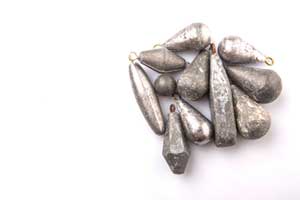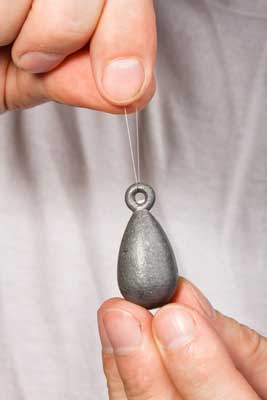Introduction to Fishing Weights

Lead was the standard for fishing weights until environmental regulations and concern about lead poisoning encouraged people to switch to less toxic substances. Common materials now used the weights include iron, copper, tin and tungsten.
What is a sinker?
- A sinker is a weight used to force a lure or bait to sink rapidly and increase the distance that it can be cast.
- Lead-based sinkers have been banned in Canada and the UK as well as some US states.
- The swivel sinker has swivels at both ends which helps prevents the line from twisting.
- The split shot is a round ball with a split down the middle, which clamps down around the line.
Maintaining the correct weight
One of the most important things to consider when choosing fishing weights is the sensitivity on the line. Just as the correct line weight is important, so is the weight. Too heavy a weight and it becomes difficult to properly determine when a fish strikes.
Excessive weight can also reduce your chances of landing a fish because it doesn’t allow the hook to be set properly.
How weights work
Now for the Physics. Torpedoes, swivels, locks, split shots are types of weights and all act differently.
Which weight should I use and where?
We’ll explain where to best use each.
For casting, ensure the weight is within the recommended weight for the rod, reel and line weight. With all that figured out, pick a weight that’s streamlined for the best flight. The key is *the more streamlined, the further it will go.
- Bell shaped or tear drop shaped weights are the most aerodynamic and are the most accurate in flight.
Once the weight hits the water, the same dynamics that act in flight will also work in water. And as water is more dense, a weight that is not hydrodynamic will not be as accurate. This can be an issue if there’s a lot of debris in the water.
You need to take into account if it’s a windy day or fast moving water. Each one will have an effect on the movement of the lure and the weight. When you want to anchor the line, still water plays little consideration on the weight type.
However when the current is fast moving, either on top of the water or below, bell shaped or tear drop weights will most likely roll about.
- For a fast moving current the best weight to use is a flat sinker which is meant to embed in the soil.
Bottom trolling sinkers include the torpedo.
These provide minimal drag and resistance. Another good choice is the bead chain as they cut down on line twist.
There’s a lot more to consider to choose the best weight, but the same 3 basic physics apply.
- the ability of the weight to slip through the air or water without much drag
- the ability of a weight to sink quickly and embed in the soil
- and the correct weight for the fishing conditions
While we focus on weights in the section, we need to also briefly touch on line bait and lure.
The weight and lure should never twist the line and allow the lure (or bait) to maintain the correct depth. Doing so will improve your fishing experience.



